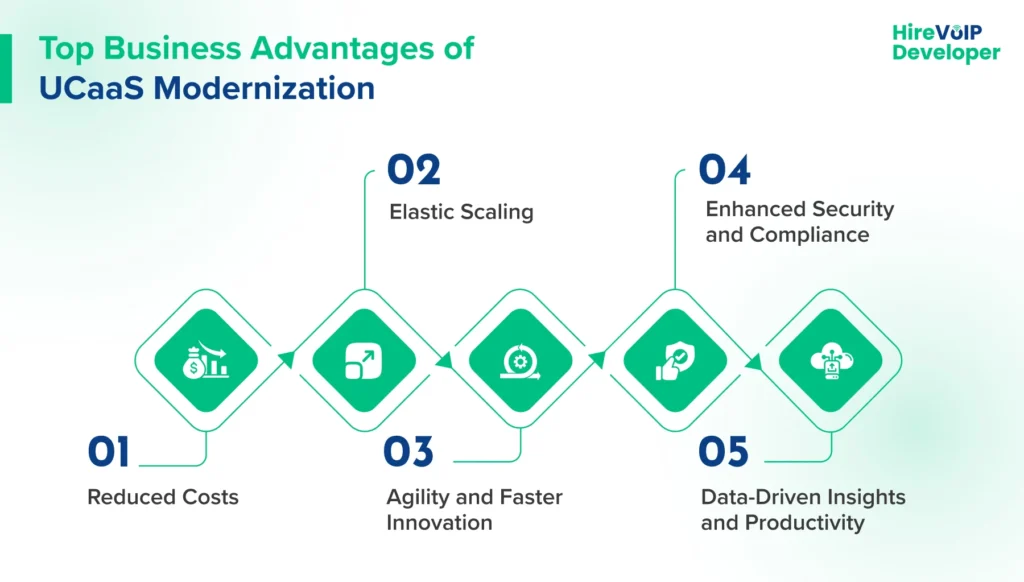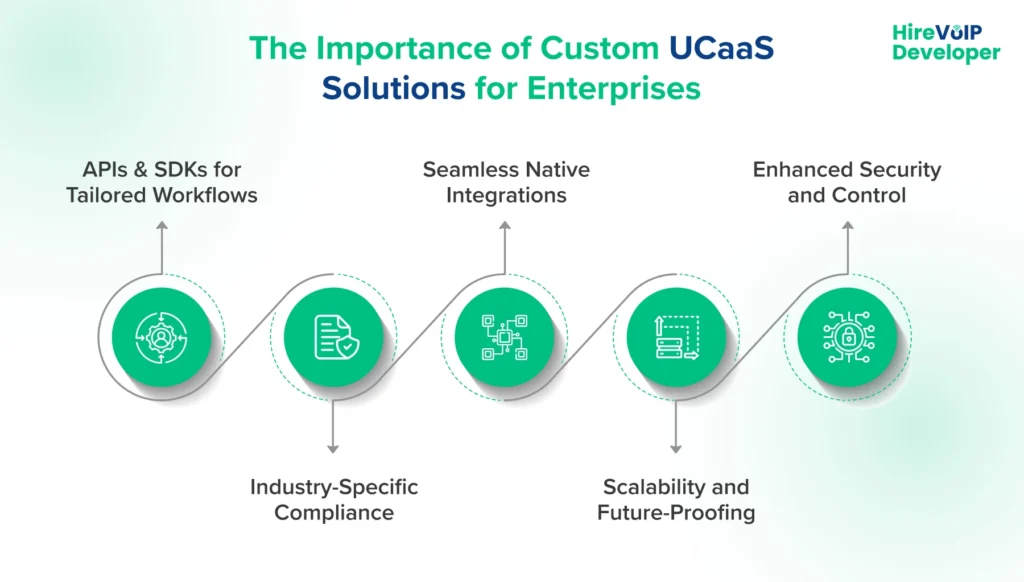📝 Blog Summary
As hybrid and remote work becomes the norm, businesses need communication platforms that are agile and reliable. This blog provides a clear breakdown of why enterprises are adopting modern, cloud-native UCaaS solutions to stay ahead.
As organizations embrace hybrid and remote work environments, the need for flexible, secure, and intelligent communication platforms has never been greater. Traditional UCaaS systems often struggle to keep pace, resulting in delays and operational friction.
However, custom UCaaS solutions, built on cloud-native architectures, allow organizations to scale effortlessly, enhance security, and simplify collaboration across teams.
For growing businesses, early adoption of these modern platforms can create a significant competitive startup advantage.
Before exploring how cloud-native UCaaS is transforming enterprise communication, it’s important to understand why legacy UCaaS systems are falling short and the challenges they create for today’s enterprises.
Why are Legacy UCaaS Systems Failing Businesses Today?
Legacy UCaaS platforms were designed in a world where voice and chat were the primary focus. Today, communication is real-time, omnichannel, and globally distributed. Businesses expect video, messaging, file sharing, and integrations with dozens of SaaS apps, all without hiccups.
Here’s why older systems fall short:
- Vertical Scaling Limitations: Most legacy platforms scale by increasing the capacity of a single, monolithic server (vertical scaling). This creates a “single point of stress”: if one component reaches its capacity, the entire system slows down. Modern microservices-based UCaaS allows horizontal scaling, adding independent service instances, so one bottleneck doesn’t cripple the platform.
- Resource Inefficiency and Hidden Costs: Beyond maintenance, legacy systems require constant manual tuning, patching, and monitoring. That’s not just a cost, it’s opportunity loss, as teams can’t focus on innovation, integrations, or customer experience.
- Innovation Inertia: In monolithic systems, adding a single new feature often necessitates regression testing across the entire platform. That delays launches, increases the risk of downtime, and creates a culture of “feature paralysis.” Modern cloud-native UCaaS platforms enable modular updates, allowing businesses to experiment without halting operations.
- Complex Integration Debt: Legacy UCaaS systems often lack robust APIs or standard connectors, resulting in complex integration debt. Adding a CRM, ERP, or AI analytics tool can require expensive custom development. Cloud-native platforms are designed with integration-first architectures, supporting third-party apps and AI-driven workflow automation from day one.
- Security and Compliance Fatigue: Older platforms were developed when cybersecurity threats were less complex and sophisticated. Today, regulations (GDPR, HIPAA, SOC 2, CCPA) require granular auditing, role-based access, and rapid incident response. Legacy systems struggle to meet these standards without extensive retrofitting, exposing businesses to compliance risks.
- Global Collaboration Blind Spots: Traditional UCaaS platforms are optimized for a single region or data center. Multi-region latency, inconsistent quality of service, and poor redundancy make international collaboration frustrating. Cloud-native solutions distribute services globally, ensuring consistent performance, redundancy, and near-zero downtime for distributed teams.
Did You Know❓
The worldwide UCaaS market was estimated at USD 48.79 billion in 2023 and is expected to climb from USD 56.75 billion in 2024 to USD 215.53 billion by 2032
What Is Cloud-Native UCaaS?
Cloud-Native UCaaS (Unified Communications as a Service) refers to a communication platform designed and built using cloud-native principles, including microservices architecture, containerization, and distributed infrastructure.
Unlike legacy monolithic UCaaS systems, cloud-native UCaaS allows independent scaling of services (voice, video, messaging), seamless integration with third-party applications via APIs, automated deployment through CI/CD pipelines, and enhanced resilience through redundancy and failover mechanisms. This design allows the system to scale, adapt, and recover without disrupting overall operations.
What are some of the core components of cloud-native UCaaS?
- Containerization (Docker): Packages applications in isolated, lightweight units, making deployment predictable and portable.
- Orchestration (Kubernetes): Automates scaling, failover, and deployment, ensuring seamless performance under varying loads.
- CI/CD Pipelines: Enables rapid feature updates and continuous innovation, often with zero downtime.
- Distributed Infrastructure: Spreads workloads across multiple regions, addressing weak links to ensure continuous and reliable system performance.
Having unpacked what powers cloud-native UCaaS, let’s compare it head-to-head with legacy UCaaS to see why businesses are making the move.
Legacy UCaaS vs Cloud-Native UCaaS
Not all UCaaS platforms are created equal. Comparing legacy UCaaS systems with cloud-native UCaaS solutions highlights why modern enterprises are moving toward microservices, scalability, and agility.
The differences are not just technical; they impact cost, performance, and the speed at which businesses can innovate.
Let’s break down the differences in key areas, such as scalability, innovation speed, resilience, and cost, to see precisely why cloud-native UCaaS stands out.
| Feature | Legacy UCaaS | Cloud-Native UCaaS |
|---|---|---|
| Scalability | Vertical only, rigid | Elastic, horizontal, auto |
| Innovation Speed | Months per release | Weekly or even daily |
| Resilience | One bug = complete outage | Failures are isolated; the system survives |
| Costs | High OPEX, resource-heavy | Optimized, pay-as-you-go |
The table clearly shows that cloud-native UCaaS offers flexibility, efficiency, and reliability that legacy systems cannot match. Organizations can expand their operations as needed, innovate faster, and maintain uninterrupted service even when parts of the system fail.
Understanding the stark differences between legacy and cloud-native UCaaS sets the stage for exploring how microservices power next-gen platforms, enabling scalability, resilience, and faster innovation.
How Do Microservices Power Next-Gen UCaaS Platforms?
Modern UCaaS platforms rely on microservices architecture to deliver flexibility, scalability, and resilience that legacy systems can’t match. By breaking down communication features, like voice, video, and messaging, microservices enable faster updates, simplified integrations, and fault isolation.
This approach enables enterprises to innovate rapidly, maintain uninterrupted operations, and seamlessly integrate with other business applications, making microservices the backbone of next-generation UCaaS platforms.
So, why are Microservices the key to modern UCaaS platforms? Here’s why:
- Independent Services: Each feature (chat, voice, video) can be built, updated, or fixed independently.
- Simplified Integrations: APIs make connecting with CRMs, AI analytics, or third-party SaaS tools far easier.
- Rapid Rollouts: New features launch faster because you don’t touch the entire system.
- Fault Tolerance: One failure doesn’t cascade through the system.
When you combine cloud-native infrastructure with microservices, you don’t just modernize, you create next-gen UCaaS platforms.
Let’s look at the benefits, too.
What are the Business Benefits of UCaaS Modernization?

Modernizing your UCaaS platform isn’t just a tech upgrade; it’s a strategic move that transforms how your business communicates, collaborates, and grows. Cloud-native UCaaS solutions and next-gen UCaaS platforms bring flexibility, resilience, and intelligence that legacy systems can’t match. Here’s how:
-
Reduced Costs
Legacy UCaaS systems demand significant IT resources for maintenance and updates. Cloud-native platforms streamline operations, reduce manual intervention, and free IT teams to focus on innovation and growth instead of constantly troubleshooting system issues.
-
Elastic Scaling
Traditional UCaaS platforms often struggle during periods of high demand, resulting in slow performance or service interruptions. Modern UCaaS platforms, built on microservice architectures, scale dynamically, automatically adjusting resources to maintain smooth communication even during peak workloads.
-
Agility and Faster Innovation
Next-gen UCaaS platforms allow modular, independent updates. This means businesses can introduce new features or enhancements without disrupting the entire system. The result is faster innovation, more responsive workflows, and a platform that evolves in tandem with your business needs.
-
Enhanced Security and Compliance
Security is no longer optional; it’s essential. Modern UCaaS platforms embed robust security protocols at their core, supporting regulatory requirements like GDPR, HIPAA, or SOC 2. AI-driven monitoring and real-time threat detection ensure that your communications remain secure without sacrificing usability.
-
Data-Driven Insights and Productivity
Cloud-native UCaaS treats communication as a rich source of actionable insights. Businesses can track collaboration patterns, identify workflow inefficiencies, and optimize processes, transforming everyday communications into a tool for more intelligent decision-making and enhanced team productivity.
UCaaS modernization isn’t just about technology; it’s about empowering your teams and business. By adopting cloud-native UCaaS solutions or custom UCaaS solutions, organizations can achieve cost efficiency, scalability, agility, enhanced security, and valuable insights.
Modernization improves efficiency, scalability, and decision-making. Still, these benefits are fully realized only when the platform is secure enough to handle critical communications, which naturally leads to the next question.
How Secure Are Cloud-Native UCaaS Platforms?
Security is a critical concern for modern enterprise communication, and cloud-native UCaaS platforms are designed with security at their core. Leveraging a combination of zero-trust architecture, end-to-end encryption, continuous monitoring, and distributed infrastructure, these platforms protect voice, video, messaging, and file-sharing traffic from both external and internal threats.
Cloud-native solutions integrate security into every layer, ensuring compliance with standards like GDPR, HIPAA, and SOC 2, while providing resiliency, rapid threat detection, and automated incident response. Modern businesses require communication platforms that are secure by design, not as an afterthought.
This is where cloud-native UCaaS solutions shine: they embed security at every layer, ensuring your calls, messages, and data remain protected in real-time.
Here are the key security advantages:
- Zero-Trust Architecture: In cloud-native UCaaS, every access request is authenticated, verified, and logged. No user or device is automatically trusted, which minimizes the risk of internal or external breaches. This approach ensures that sensitive information stays protected, even when employees access systems from multiple locations or devices.
- End-to-End Encryption: Modern platforms encrypt communication both in transit and at rest, covering voice calls, video conferences, chat messages, and file transfers. This protects your organization from eavesdropping, data leaks, and cyberattacks, providing peace of mind for both IT leaders and end-users.
- Disaster Recovery and Resiliency: Distributed cloud infrastructure ensures your UCaaS platform remains available even during outages or regional disruptions. Automatic failovers, backups, and redundancy mean business continuity is maintained without manual intervention.
- Continuous Security Updates and Compliance: Cloud-native UCaaS providers continually update security protocols, patch vulnerabilities, and maintain compliance with evolving regulatory standards, including GDPR, HIPAA, and SOC 2. Legacy systems often struggle to meet these requirements, creating hidden risks for businesses.
Once you’ve established a secure foundation, the next natural step is customization.
With modern UCaaS platforms, businesses can tailor workflows, integrations, and user experiences while maintaining security and compliance, allowing teams to work smarter without compromising safety. Let’s take a look.
Why Do Enterprises Need Custom UCaaS Solutions?

Standard UCaaS platforms often fail to meet the unique demands of enterprise operations. Different teams, complex workflows, and strict regulatory requirements mean that a generic system can slow productivity rather than enhance it.
Custom UCaaS solutions provide the flexibility to tailor communication platforms precisely to an organization’s needs, turning UCaaS into a strategic tool rather than just another software. Let us take a look at the key advantages of custom UCaaS solutions:
- APIs & SDKs for Tailored Workflows: Custom UCaaS platforms offer robust APIs and software development kits (SDKs), enabling businesses to automate processes, integrate communication with internal tools, and create workflows that align with how teams actually work. This flexibility ensures that the platform adapts to the enterprise, rather than forcing the enterprise to adjust to it.
- Industry-Specific Compliance: Different industries have distinct regulatory demands. Healthcare organizations require HIPAA compliance, financial firms must adhere to PCI DSS, and global businesses must meet GDPR or SOC 2 standards. Custom UCaaS solutions ensure these requirements are built into the system from the ground up, reducing risk while maintaining operational efficiency.
- Seamless Native Integrations: Enterprises rely on multiple systems, CRM, ERP, HR platforms, analytics tools, and communication platforms, which must integrate smoothly with them. Custom UCaaS solutions enable native integrations that unify data, streamline processes, and optimize customer experience. Teams can respond faster, collaborate more effectively, and make informed decisions based on real-time insights.
- Scalability and Future-Proofing: Custom UCaaS isn’t just about today; it’s about preparing for tomorrow. Businesses can scale features, add new communication channels, and adapt to emerging technologies like AI-driven analytics or edge computing without having to overhaul the entire platform.
- Enhanced Security and Control: Enterprises can define granular access controls, encryption protocols, and audit logs tailored to their security policies. This level of customization ensures sensitive data remains protected while meeting organizational standards.
While customization facilitates immense value, it’s only effective if migration from legacy systems is seamless. Poorly executed transitions can disrupt operations, frustrate employees, and reduce ROI.
The next step is to plan a smooth migration strategy, ensuring that enterprises transition to cloud-native, microservices-based UCaaS without downtime or data loss.
Did You Know❓
By 2025, 51% of IT spending is expected to shift from traditional solutions to the public cloud, up from 41% in 2022. This includes spending on application software, infrastructure software, business process services, and system infrastructure.
What are the Challenges of Migrating UCaaS to the Cloud?
Migrating to UCaaS can feel like moving an entire city; data, people, systems, and processes all need to shift seamlessly without disruption.
Let us understand the common hurdles businesses face during UCaaS migration:
- Data Migration: Old logs, recordings, and user data must be moved safely.
- Training Gaps: Teams resist change unless onboarding is smooth.
- Vendor Lock-in Fears: Selecting providers that enable portability and offer open APIs.
Next, let’s examine solutions that make UCaaS migration smoother and less risky:
- Hybrid Migration: Run both old and new systems in parallel during the transition.
- Phased Rollouts: Roll out features team by team.
- Expert Partners: Collaborating with experienced migration specialists can help ensure a smooth and low-risk transition.
Successfully navigating these migration challenges positions enterprises to fully leverage cloud-native UCaaS, setting the stage to explore what the future of UCaaS looks like in 2025 and beyond.
What’s the Future of UCaaS in 2026?
The UCaaS industry isn’t just evolving, it’s accelerating at an unprecedented pace. While cloud-native UCaaS solutions and microservices architectures are redefining today’s platforms, the future belongs to technologies that amplify intelligence, speed, and connectivity.

Key Trends in Next-Gen UCaaS Platforms:
- AI-First Communication: Artificial intelligence is moving beyond simple chatbots or voice commands. Predictive call routing anticipates user needs, live transcription ensures that no detail is lost, and sentiment analysis can gauge customer emotions in real-time. AI will also enable intelligent analytics, helping organizations identify patterns, optimize workflows, and proactively improve customer satisfaction.
With the evolution of AI, UCaaS platforms deliver adaptive intelligence and predictive insights that continuously refine communication, serving as a key enabler of growth.
- 5G Connectivity: The rollout of 5G networks is a game-changer for UCaaS. It ensures employees, partners, and customers can communicate seamlessly anytime, anywhere, turning custom UCaaS solutions into a mobility-first, always-on experience.
- Hyper-Personalization & Integration: Future UCaaS platforms will adapt to individual users and business contexts. From integrating with CRM, ERP, and analytics tools to automating repetitive workflows, personalization ensures communication systems work smarter, not harder. Organizations can tailor every workflow without overhauling the entire system, a significant leap from rigid legacy UCaaS platforms.
- Security & Compliance by Design: As cyber threats grow and regulations tighten, UCaaS platforms are embedding AI-driven security and compliance monitoring at the core. Real-time anomaly detection, encryption, and role-based access will ensure businesses stay protected without compromising speed or usability.
Businesses that adopt cloud-native UCaaS solutions today, combined with microservices architectures, edge computing, AI, and 5G, will redefine how teams collaborate and innovate.
The only question is: are you ready to transform your communication platform into a strategic growth engine for 2025 and beyond?
In a Nutshell
Legacy UCaaS is the flip phone of communication; it worked once, but nobody wants it anymore. The combination of cloud-native UCaaS solutions and microservices has already defined UCaaS modernization and built the foundation for next-gen UCaaS platforms.
Add in custom UCaaS solutions, and you’ve got communication systems that are faster, cheaper, and smarter. The question is simple: do you want to modernize now, or scramble to catch up later?
Ready to modernize your UCaaS? Build your UCaaS with experts. At Hire VoIP Developers, get experienced professionals to design and deploy next-gen UCaaS platforms. Get in touch today!
FAQs


